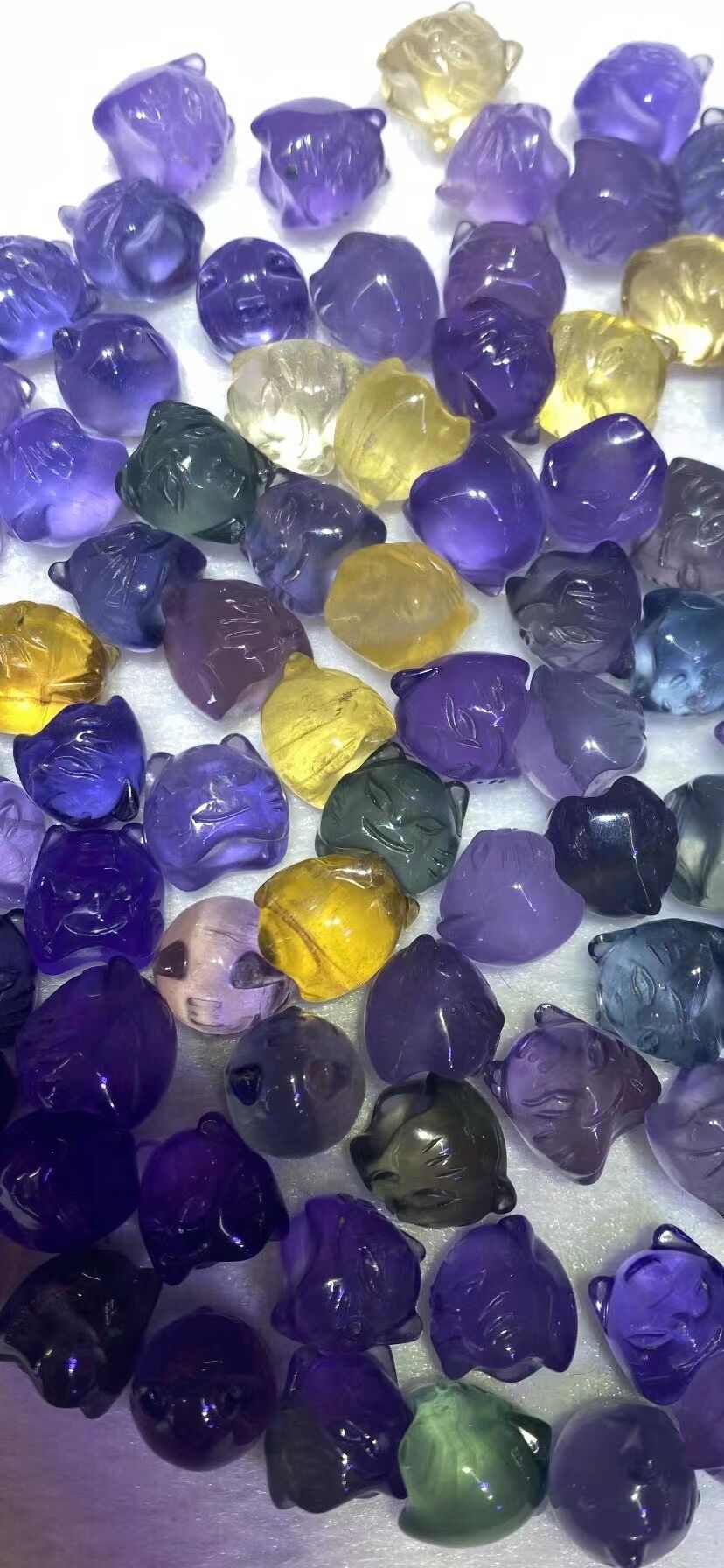Faceted fluorite for jewelry making
Faceted fluorite for jewelry making
Fluorite is rich in reserves and has a natural beauty. Among thousands of minerals, it is unique in its colorful, different shapes and luminous characteristics, giving people a dreamlike beauty.
Fluorite is known as "the most colorful mineral in the world", comparable to the tourmalines known as "colorful gems" and "rainbow gems". In recent years, with the popularity of tourmaline and its soaring price, fluorite has also ushered in its own spring
Fluorite into the carat era
Once upon a time, fluorite has been excluded from the ranks of traditional gems because of its softness, fragility, weak luster and fire color. It is generally not used in the traditional jewelry industry, but is mostly used for viewing, collection and display. It is occasionally polished into facets. Gems are only used for display in professional museums or collections of gems for jewelry enthusiasts.
Only massive or striped fluorite aggregates rank among the ranks of jade and are used as jade carving materials. Nowadays, as an upstart gem, fluorite, like other precious gems, is also priced in "carat (1 carat=0.2g)", especially the color-changing fluorite (dark blue during the day and purple at night) is full of charm. The discoloration effect is very popular among jewelry collectors.
Fluorite is a kind of calcium fluoride (CaFâ‚‚) mineral with simple composition in nature and reaching gem level, also known as "fluorspar". The most peculiar thing is that fluorite emits firefly-like fluorescence no matter it is irradiated by ultraviolet rays or cathode rays, which is the origin of its name.
The English name of fluorite is Fluorite, which is derived from the Latin Fluere. This name has undergone several changes: from generally referring to all fusible minerals and minerals that can be used as fluxes, to only referring to fluorine-containing minerals, and then to specifically referring to the main fluorine-containing mineral-fluorite.
Fluorite history
Although the name "fluorite" appeared late, it was discovered and used very early. For example, as early as the Neolithic Age, the Hemudu people south of the lower reaches of the Yangtze River in my country used fluorite as decorations, and it has a long history of nearly 7,000 years. The collection of the Palace Museum in Beijing has a gem seal made of fluorite from Emperor Qianlong of the Qing Dynasty, which shows that the Chinese people love fluorite.
In foreign countries, fluorite is also widely loved by people from all over the world, and from ancient treasures to modern laboratory supplies and collectibles
Whether it is a gem-level single crystal fluorite or a jade-level fluorite aggregate, each can be subdivided according to its color, structure or texture, special optical effects and special phenomena
Gem-grade fluorite: single crystal (including twin crystals), large particles, fully transparent, easy to scratch due to low hardness, easy to break due to cleavage development, it was rarely used in jewelry in the past. With the improvement of gem cutting technology and the improvement of cutting tools, the delicate fluorite can also be cut into exquisite faceted gems.
Purple fluorite: fluorite crystals in deep purple, purple and light purple, as well as violet, often distributed in strips. The appearance of this kind of fluorite resembles amethyst, and it is called "False Amethyst" in foreign countries; but its hardness is lower than that of amethyst. The ancient saying of "soft water amethyst" in our country is no longer used. Purple fluorite from De'an in Jiangxi and Dushan in Guizhou is the most representative.
Green fluorite: blue-green, green and light green fluorite crystals, common crystal clusters. When it is cut into an emerald type, it resembles an emerald. It is called "False Emerald" abroad; because its hardness is lower than that of green crystal, the ancient saying of "soft water green crystal" is no longer used. Namibia produces emerald green fluorite.
Blue fluorite: blue, green-blue, light blue, gray-blue or even blue-black fluorite crystals, often with dark surface color and light center color. The blue fluorites from Yaogangxian in Hunan and Yongchun in Fujian are the most representative in our country.

Yellow fluorite: orange to yellow and wine-yellow fluorite crystals. Mainly produced in the United States, Spain and Italy.
Pink fluorite: pink fluorite crystals, rare and precious. It is mainly produced in the Alps at the junction of France and Switzerland-located in central and southern Europe. In recent years, Pakistan and Chifeng, Inner Mongolia, have also produced production.
Colorless fluorite: A colorless, transparent to translucent fluorite crystal, often appearing as single crystals or crystal clusters. It is mainly produced in Canada, the United States, Peru and other places, and also produced in Hunan and Inner Mongolia of my country.
Two-color fluorite: refers to the fluorite crystals that show two colors in the same crystal, and form distinct color bands with the outline of the crystal face—showing changes in the environment during the growth process. The most common combination is green and purple. France has purple-yellow double-color fluorspar, and my country's Hunan Yaogangxian area produces green-purple double-color fluorspar.
Color-changing fluorite: refers to fluorite crystals showing different colors under different light sources. For example, the color-changing fluorite of Madagascar and Brazil is blue or dark blue in daylight, purple in incandescent light, and when the wavelength of the light is different, it will also produce fluorescence, which presents a different beauty. It is also found in Ji’an, Jiangxi, my country. output.
Fluorite "Night Pearl": refers to fluorite with phosphorescent effect, transparent to translucent, mostly green (including dark green, dark green and light green) and purple, usually green phosphorescence is stronger than purple. In addition, there is also a fluorite with thermoluminescence properties—Chlorophane (Chlorophane), which emits green light when heated.
Jade-grade fluorite: often granular or fibrous fluorite aggregates, in a clump, spherical, grape-like or vein-like structure, with a single color and different colors alternately appearing in strips, translucent, and mostly used for jade carvings , Decoration materials.
Blue John: The English name Blue John comes from the French "Bleu Jaune", which means "blue-yellow". Especially refers to the fluorite with purple, green, white or yellow interspersed in strips, and the fluorite with blue, purple, purplish red and nearly black bands on a white or light red base. This is due to the periodic injection of liquids with different compositions during the crystallization process of fluorite. It was originally produced mainly in Derbyshire, England, and also produced in Wuyi, Zhejiang, my country.
Green John: The English name Green John refers to massive green fluorite. It is mainly produced in the United Kingdom, but also produced in Jiangxi and other provinces in my country.
Of course, in addition to the most famous blue John and Green John among jade-grade fluorites, light yellow, orange to brick red spherical fluorites have been discovered in India in recent years; purple spherical, kidney-shaped or grapes have been found in Guxian, Henan, my country. Fluorite, dark blue fluorite aggregates were found in Huanggangliang area of Inner Mongolia, gray-green spherical fluorite (some with quartz crust on the surface) was found in Anxi, Fujian and Chenzhou, Hunan, which can be used for ornamental purposes or Polished into a cabochon gem, it can also be used for carving.

Fluorite maintenance cheats
Wearing: It is required to avoid impact and keep away from high heat. The hardness of fluorite is extremely low, the Mohs hardness is only 4, and it has complete cleavage, so its toughness is extremely poor, especially for those fluorites with more inclusions or wool, even if fluorite aggregates or jade There may still be weaknesses in grade fluorite. In the process of wearing, it is necessary to avoid hitting with hard objects to avoid damage or breakage of edges and corners.
Fluorite is resistant to heat, and fluorite with abundant liquid inclusions or cracks developed cannot withstand the test of heat. Sudden temperature changes (thermal shock) can cause cracks. High heat environment must be avoided. High temperature work is best not to wear Fluorite jewelry.
Cleaning: It is required to flick to remove dust and clean with warm water. The hardness of fluorite is too low, so remember not to wipe it with a dry hard cloth containing wool, otherwise it will be easily worn. Fluorite is afraid of acid, so avoid contact with acid when cleaning.
Fluorite jewelry can be soaked in salt water or soapy water at room temperature, then cleaned with a soft toothbrush, rinsed with clean water, and finally dried with a clean soft cloth.
Pay attention to the development of fluorite cleavage or cracks, especially for filling and processing fluorite, and avoid steam cleaning, chemical cleaning and ultrasonic cleaning. Warm soapy water is the best way to clean fluorite.
Storage: Handle with care and care. Fluorite is soft and brittle, so it should be avoided from being damaged by squeezing or violent collision. Never store loose fluorite stone and its jewelry together with any gemstone and its jewelry with a hardness higher or lower than 4 to avoid scratches or scratches.
It is best to pack them separately and store them in a jewelry box lined with fabric. Loose fluorite stone and its jewelry must be stored in a safe, fire-proof, high-temperature, and radiation-proof place.

Contact: :AnnaHe
Mobile/Wechat/WhatsApp : +86 13751114848
Contact :JeamChen
Mobile/Wechat/WhatsApp: +86 13425105392
Email: info@TurquoiseChina.com
Company address:
Room 1307 Tower A,Yanlord Dream Center,Longcheng Street, Longgang District, Shenzhen,Guangdong Province,China 518172
See the surprise, please consult our customers.


Become An Insider











































































































